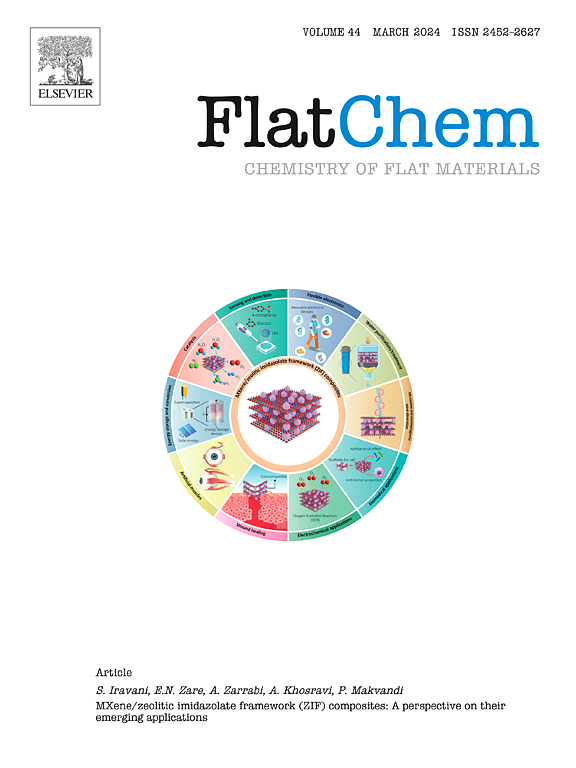Engineering two-dimensional supramolecular self-assembly: The role of Cl atoms
IF 5.9
3区 材料科学
Q2 CHEMISTRY, PHYSICAL
引用次数: 0
Abstract
On-surface synthesis is a powerful tool for engineering two-dimensional (2D) organic nanostructures by controlling intermolecular interactions between the building blocks. Herein, we explore the role of Cl adatoms in the synthesis and characterization of self-assembled 1,3,5-tris[4-(pyridin)-[1,1’-biphenyl]benzene (TPyPPB) networks on Ag(111), by combining scanning tunneling microscopy (STM), X-ray photoelectron spectroscopy (XPS), and density functional theory (DFT). In the absence of Cl, upon deposition at room temperature (RT), TPyPPB molecules form a highly ordered porous supramolecular network with triangular packing, stabilized by hydrogen bonds (NH). In the presence of Cl adatoms, sublimated onto the surface using dichloro-(1,10-phenanthrolin)-platin(II) (Cl2PhPt) a second molecular precursor, we observe a so-called mixed phase or inverted packing, depending on the applied growth procedure. The mixed phase is characterized by a non-periodic structure stabilized by intermolecular interactions between TPyPPB, Cl2PhPt, and Cl. In contrast, when only Cl adatoms and TPyPPB are present on the Ag(111) surface, a non-porous supramolecular arrangement is obtained, stabilized by C–HCl hydrogen bonds.

工程二维超分子自组装:Cl原子的作用
表面合成是通过控制构建单元之间的分子间相互作用来设计二维有机纳米结构的有力工具。本文采用扫描隧道显微镜(STM)、x射线光电子能谱(XPS)和密度泛函理论(DFT)相结合的方法,探讨了Cl原子在银(111)上自组装1,3,5-三[4-(吡啶)-[1,1 ' -联苯]苯(TPyPPB)网络的合成和表征中的作用。在没有Cl的情况下,在室温(RT)下沉积后,TPyPPB分子形成具有三角形包装的高度有序的多孔超分子网络,由氢键(N⋯H)稳定。在氯原子存在的情况下,使用二氯-(1,10-菲罗啉)-铂(II) (Cl2PhPt)第二分子前体升华到表面,我们观察到所谓的混合相或反向堆积,这取决于应用的生长程序。混合相的特点是由TPyPPB、Cl2PhPt和Cl之间的分子间相互作用稳定的非周期性结构。相反,当Ag(111)表面仅存在Cl原子和TPyPPB时,可以获得无孔的超分子排列,由C-H⋯Cl氢键稳定。
本文章由计算机程序翻译,如有差异,请以英文原文为准。
求助全文
约1分钟内获得全文
求助全文
来源期刊

FlatChem
Multiple-
CiteScore
8.40
自引率
6.50%
发文量
104
审稿时长
26 days
期刊介绍:
FlatChem - Chemistry of Flat Materials, a new voice in the community, publishes original and significant, cutting-edge research related to the chemistry of graphene and related 2D & layered materials. The overall aim of the journal is to combine the chemistry and applications of these materials, where the submission of communications, full papers, and concepts should contain chemistry in a materials context, which can be both experimental and/or theoretical. In addition to original research articles, FlatChem also offers reviews, minireviews, highlights and perspectives on the future of this research area with the scientific leaders in fields related to Flat Materials. Topics of interest include, but are not limited to, the following: -Design, synthesis, applications and investigation of graphene, graphene related materials and other 2D & layered materials (for example Silicene, Germanene, Phosphorene, MXenes, Boron nitride, Transition metal dichalcogenides) -Characterization of these materials using all forms of spectroscopy and microscopy techniques -Chemical modification or functionalization and dispersion of these materials, as well as interactions with other materials -Exploring the surface chemistry of these materials for applications in: Sensors or detectors in electrochemical/Lab on a Chip devices, Composite materials, Membranes, Environment technology, Catalysis for energy storage and conversion (for example fuel cells, supercapacitors, batteries, hydrogen storage), Biomedical technology (drug delivery, biosensing, bioimaging)
 求助内容:
求助内容: 应助结果提醒方式:
应助结果提醒方式:


